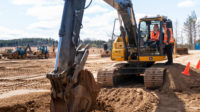Rather than working from reams of paper, the Wisconsin Dept. of Transportation (WisDOT) opted to reconstruct the Zoo Interchange in downtown Milwaukee by working from gigabytes of 3D data—modeling virtually every aspect of the $1.7-billion project.
Related Links:
Indiana Punches U.S. 31 Rehab Into the Fast Lane
Pre-Assembly Puts Plant Upgrade in Ship Shape
WisDOT invested heavily in computer hardware to support the effort, having acquired stationary and mobile lidar laser-mapping units, various desktop and laptop computers, field-rugged tablet computers and GPS rovers for field inspections. Milwaukee-based engineer Kapur & Associates, which led the modeling effort, invested about $500,000 in new servers to accommodate the 2 terabytes of lidar data it collected surveying the project. Resulting models have enhanced collaborative efforts among the project’s multiple stakeholders and promoted quicker and easier clash resolutions during design, the intent being to reconstruct one of Milwaukee’s central arteries as soundly and cost-efficiently as possible.
Fewer Change orders
So far, work is proceeding according to plan, says Lance Parve, WisDOT’s construction information management (CIM) engineer for design construction. “We’re finding that modeling all the different components is providing a major means of reducing conflicts and contract change orders and achieving real return-on-investment improvements,” he says.
The rebuild is long overdue, say project team members. Completed in 1963 and currently accommodating up to 350,000 vehicles a day, the Zoo—so named for its proximity to Milwaukee County Zoo—is Wisconsin’s oldest and busiest freeway interchange, marking the confluence of Interstate 94, I-894 and U.S. 45. By 2010, the interchange had reached the end of its useful life, prompting ad hoc replacement of several bridge sections so deteriorated that repairs no longer could be postponed. Plans for a full-scale replacement were well underway by then.
Begun in 2013, complete rebuild of the interchange entails reconstruction of a 12-mile freeway corridor leading to and through it, along with seven service interchanges, including 68 bridges—six of them railroad structures—108 retaining walls and 14 sound walls. Forward 45, a joint venture of engineers CH2M, Englewood, Colo.; HNTB, Kansas City, Mo.; and Kapur & Associates, in addition to about 20 subconsultants, is leading the design effort, with WisDOT pitching in to design about 40% of the structures.
A primary goal of the project is to improve safety, prompting plans to shift on- and off-ramps from the left to the right side of the freeways in order to extend merge distances and lengthen sight distances. The completed project also should improve efficiency, since “traffic is well beyond the capacity of the original interchange,” says Bill Mohr, WisDOT’s supervisor of southeast freeways.
When completed, its replacement will incorporate a variety of bridge types: prestressed concrete girder structures, steel I-beam structures and steel box-girder structures for the longer flyovers.
Modeled components include earthwork for automated machine guidance, utilities and subsurface structures, and all above-grade structures, including the project’s many bridges.
Kapur’s primary focus involved surveying the site and determining the location of utilities, for which it deployed software such as TopoDOT and InRoads to accommodate the millions of data points generated by lidar mapping. Additionally, Kapur is employing Terramodel to export model data to the GPS rovers that inspection staff have on hand at the project site. Kapur also converts files to Civil 3D for WisDOT.
HNTB, meantime, has focused on roadway engineering, structure design, geotechnical design, utility design, traffic analysis, ITS design, traffic signal design, landscape architecture and drainage design. CH2M, for its part, has executed roadway design, structure design and geotechnical engineering.
Each of the engineers modeled its components individually. When designs were 60% complete, team members gathered to detect clashes, such as misalignment of a sound wall relative to a storm sewer. Team members performed a second round of clash detection when designs were 90% complete, after which all clashes were to have been detected.
The approach proved advantageous at another key interval, says Dan Kucza, survey manager with Kapur. “We were able to provide contractors with models pre-bid, the objective being to lower the bids since the contractors weren’t required to build models of their own to price the job,” he says.
Before models could be turned over to bidders, team members needed to convert elements to an Autodesk Civil 3D format, the 3D standard selected by WisDOT.







